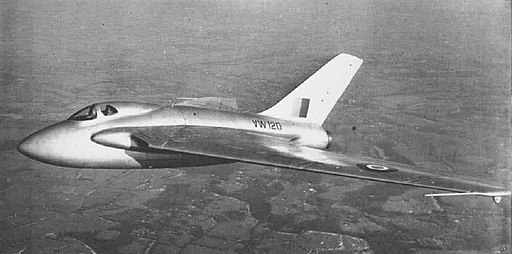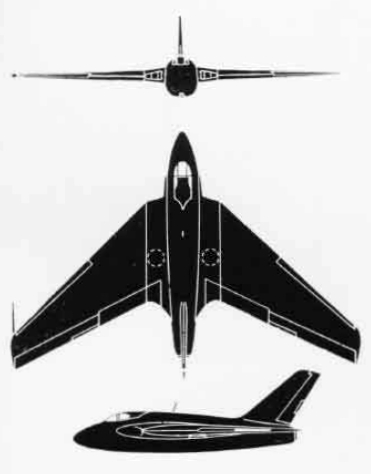
ASN Wikibase Occurrence # 139759
This information is added by users of ASN. Neither ASN nor the Flight Safety Foundation are responsible for the completeness or correctness of this information.
If you feel this information is incomplete or incorrect, you can submit corrected information.
| Date: | Wednesday 15 February 1950 |
| Time: | day |
| Type: | de Havilland DH.108 Swallow |
| Owner/operator: | RAE Farnborough |
| Registration: | VW120 |
| MSN: | 03 |
| Fatalities: | Fatalities: 1 / Occupants: 1 |
| Aircraft damage: | Destroyed |
| Location: | Little Brickhill, near Bletchley, Buckinghamshire -
 United Kingdom United Kingdom
|
| Phase: | Manoeuvring (airshow, firefighting, ag.ops.) |
| Nature: | Test |
| Departure airport: | Farnborough, Hampshire (EGLF) |
| Confidence Rating: |
De Havilland DH.108 Swallow: Third (or three) experimental research and development aircraft. Crashed and destroyed 15/2/1950 on a test flight at Birkhill, near Bletchley, Buckinghamshire. Purpose of flight was to observe longitudinal stability and aeroelasticity at high Mach numbers at 38,000ft. The aircraft broke up during a steep dive from 27,000 feet.Accident investigation pointed to a faulty oxygen system that incapacitated the pilot, Squadron-Leader J.S.R. Muller-Rowland, the Officer Commanding of the Royal Aircraft Establishment
The test flight was supposed to examine the effects of change from sub-sonic to transonic flight, but the aircraft is thought to have broken up whilst in a dive. The inquest into Muller-Rowland's death was opened two days later by North Bucks Coroner Mr E T Ray at Bletchley. Witnesses told of hearing an explosion. (Note: it is not clear if this "explosion" was the cause of the aircraft breaking up or a sonic boom.)
Some of the wreckage came down at Little Brickhill, the cockpit came down somewhere near Bow Brickhill church. Other pieces were found as far away as Husborne Crawley. Muller-Rowland's body was found near Sandy Lane between Bow Brickhill and Woburn Lane. Woburn, Bletchley and Leighton Buzzard fire brigades were all called out to attend the accident. Because of the secrecy of the aircraft the local police sealed the area to keep the public away, and after the crash police officers visited local schools to appeal for any 'souvenirs' to be returned.
The accident investigation pointed to a faulty oxygen system that incapacitated the pilot. A coroner's report published in the local newspaper one month later confirmed that the pilot died from a broken neck. The failure of the left wing as the plane dived, occurred just above the garage at Brickhill. This failure was presumed to be the source of a "bang" described by witnesses at Brickhill. Swishing sounds which were reported came from the aircraft spinning at a high rate due to it having only one wing. It came down in the woods after glancing off an oak tree; the traces of the impact were still visible 50 years later. The airframe and right wing were dismantled by the military, and removed very quickly. The left wing was also recovered from the fields just north of Brickhill.
A nearby German field worker ran over to the crash site and was met by the mechanic from Brickhill garage who had rushed to the crash site in his car to offer assistance. The pilot was already dead. A search for the crash site in 2001 by a local using a metal detector was successful. He found some of the mounting bolts "cone shaped" that were removed when the remains had been dismantled on site. The tree that the DH 108 had hit was also found, with the scar still visible in 2001. The earlier theory that a faulty oxygen system was the cause was ruled out by the coroner in his later report.
Crew of DH.108 VW120
Squadron Leader John Stuart Muller-Rowland DSO DFC, Officer Commanding Aero Flight, RAE Farnborough
Sources:
1. Halley, James (1999). Broken Wings – Post-War Royal Air Force Accidents. Tunbridge Wells: Air-Britain (Historians) Ltd. p.99 ISBN 0-85130-290-4.
2. Last Take-off: A Record of RAF Aircraft Losses 1950 to 1953 Colin Cummings p 35
3. National Archives (PRO Kew) File BT233/8: https://discovery.nationalarchives.gov.uk/details/r/C424129
4. National Archives (PRO Kew) File AVIA 5/30/S2482: https://discovery.nationalarchives.gov.uk/details/r/C6578328
5. https://en.wikipedia.org/wiki/De_Havilland_DH_108
6. http://www.bowbrickhill.com/dehavillandcrash.html
7. https://www.wingleader.co.uk/A-Very-British-Sound-Barrier-p/soundbarrier.htm
8. https://www.thunder-and-lightnings.co.uk/memorial/entry.php?id=198
9. http://thetartanterror.blogspot.com/2011/02/sldr-stuart-muller-rowland-dfc-1921.html
Media:
DH 108 VW120 in flight, in 1949:
 3-side view of the De Havilland DH.108 Swallow VW120
3-side view of the De Havilland DH.108 Swallow VW120

12 April 1948. The de Havilland DH 108 "Swallow" VW120 established a new World Air Speed Record of 604.98 mph on a 62 mile circuit. pic.twitter.com/pL0o16AgR8
— Ron Eisele (@ron_eisele) 12 April 2019
Revision history:
| Date/time | Contributor | Updates |
|---|---|---|
| 09-Nov-2011 22:49 | angels one five | Added |
| 15-Jan-2013 11:14 | Nepa | Updated [Operator, Narrative] |
| 26-Feb-2013 21:46 | Dr. John Smith | Updated [Registration, Operator, Location, Departure airport, Source, Embed code, Damage, Narrative] |
| 29-Dec-2018 20:18 | TB | Updated [Aircraft type, Cn, Location, Source, Embed code, Narrative] |
| 28-Nov-2019 21:15 | Nepa | Updated [Operator, Operator] |
| 23-Dec-2019 21:54 | Dr. John Smith | Updated [Time, Location, Departure airport, Source, Embed code, Narrative] |
| 23-Dec-2019 21:55 | Dr. John Smith | Updated [Source, Embed code] |
Corrections or additions? ... Edit this accident description
The Aviation Safety Network is an exclusive service provided by:


 ©2024 Flight Safety Foundation
©2024 Flight Safety Foundation